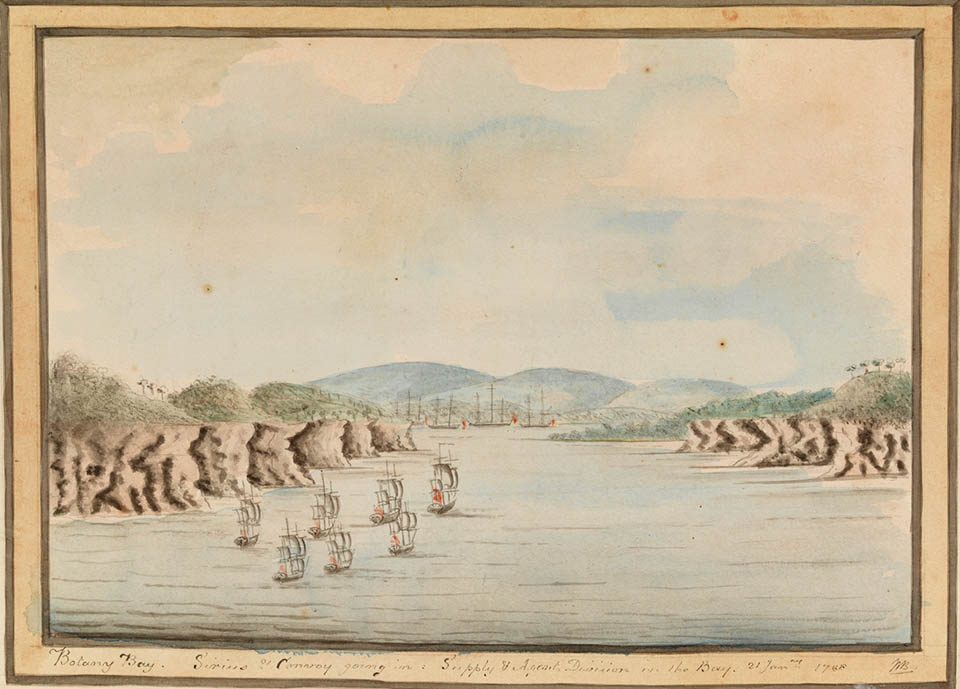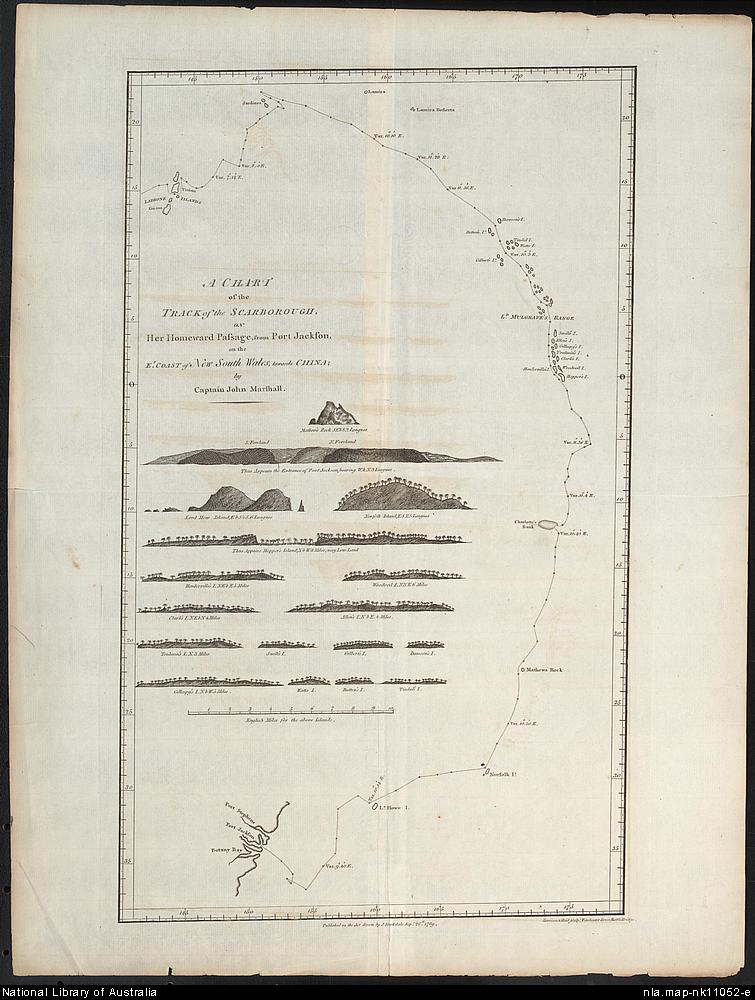The Dictionary of Sydney was archived in 2021.
Scarborough
Citation
Persistent URL for this entry
To cite this entry in text
To cite this entry in a Wikipedia footnote citation
To cite this entry as a Wikipedia External link
Scarborough
Scarborough, [media]also known as ' Scarboro', [1] was a British merchant vessel that transported convicts to the penal colony of New South Wales as part of both the First and Second fleets. The Scarborough's convict passengers on both voyages were exclusively male but marines and their families as well as crew were also on board. This ship was the only one of the First Fleet whose convict passengers plotted a mutiny, albeit one that was swiftly uncovered and thwarted. [2]
The ship's name derives from Scarborough, North Yorkshire, where it was built in 1782 as a merchant ship. In 1787 the two-decked, three-masted barque with a narrow, square stern and a flat bottom [3] was chartered from her merchant owners, Thomas, George and John Hopper by the Navy Board on behalf of the Home Office for use as a convict transport.
The First Fleet
Scarborough, [media]under the command of Captain John Marshall, carried approximately 30 crew and 50 marines, including Private John Easty, who kept a journal, [4] and Dennis Considen who served as the convicts' surgeon.
The second largest of the First Fleet vessels, Scarborough weighed 411 tons, and measured 111 feet and six inches (34 metres) in length, 30 feet and 2 inches (9.2 metres) breadth, and six feet and one inch, six feet and two inches, and five feet and eleven inches between decks.
Reportedly, a total of 208 male convicts were to be transported on the Scarborough. [5] However, one died on the Dunkirk prison hulk lying in the Hamoaze, Plymouth, before any of the convicts had been transferred to the Scarborough, and a second died at Portsmouth before embarkation. A third convict died after falling overboard en route from England to Botany Bay in November 1787.
On 20 March 1787, convict John Irving (also called Irvin and Irvine) was transferred from Scarborough to Lady Penrhyn to act as surgeon's mate, following the discovery of his surgical skills and experience. [6] Irving was subsequently the first convict to be emancipated and acted as Assistant Surgeon at a number of hospitals including Parramatta's first hospital. [7]
A further three of Scarborough's convicts were transferred to other transport ships during the voyage. Most notable of these transfers were former seamen 24-year-old Philip Farrell and 28-year-old Thomas Griffiths, who were marked as instigators of the expedition's solitary and unsuccessful mutiny plot [8] reported to Captain Arthur Phillip. Following punishment aboard the Sirius on 20 May 1787, the would-be mutineers were transferred to the Prince of Wales at sea. [9]
James Ruse, another Scarborough convict, achieved notoriety for more positive reasons. The industrious agriculturalist became the first emancipist to apply for and ultimately receive a land grant in Australia on the site of Parramatta's Experiment Farm.
Several other convicts went on to become successful farmers in the new colony including: Matthew Everingham, who farmed around Parramatta and later in the Hawkesbury; David Kilpatrick (also called Killpack and Kilpack), who received the first land grant in the Epping area; and Charles William (also called Williams and Magee) who received the first land grant at Camellia. Nathaniel Lucas also made a good life for himself in the colony working as a carpenter, miller and trader. Lucas accompanied Lieutenant-Governor Philip Gidley King to Norfolk Island later staying on in the settlement with his family.
Arrival
[media]The Scarborough arrived at Botany Bay on 19 January 1788. As this site was ill suited for settlement the fleet moved to Port Jackson on 26 January 1788. On 6 May 1788, Scarborough left Sydney Cove bound for Canton, China to collect a cargo of tea under contract to the East India Company and to conduct private trade. [10] Charlotte left two days later. [media]Along the way, Scarborough and Charlotte passed, named and mapped islands previously uncharted by Europeans, including the Marshall and Gilbert Islands (now Kiribati). Scarborough returned to England on 28 May 1789 and was repaired in readiness for her inclusion as one of six transports in the Second Fleet. The future pioneers of Australia's wool industry, John and Elizabeth Macarthur, travelled on board Scarborough for part of this voyage to Sydney. [11]
Scarborough reached Sydney Cove on 28 June 1790 and, by 8 August 1790, was repeating the homeward journey to England it had made in 1788, travelling via Canton for trade purposes.
[media]Upon returning to England in 1791, Scarborough was considered, but ultimately rejected, for further service as a convict ship in 1792. Henceforth, Scarborough was engaged in commercial activities on the London to St Petersburg run, and later the London to Jamaica run, followed by voyages from London to St Vincent (Caribbean), and London to Tobago. Beyond this, the fate of the vessel is uncertain but she may have incurred damages that caused heavy leakage off the coast of Port Royal, Jamaica in 1805. The same year, Scarborough appeared for the final time in Lloyd's Register. [12]
References
Bateson, Charles. The Convict Ships. Glasgow: Son & Ferguson, 1969.
Easty, John. Memorandum of Transactions of a Voyage from England to Botany Bay, 1787–1791: A First Fleet Journal. Sydney: Trustees of the Public Library of New South Wales, 1965. Online at http://acms.sl.nsw.gov.au/_transcript/2007/D00007/a1145.html
White, John. Journal of a Voyage to New South Wales: With Sixty-Five Plates of Non Descript Animals, Birds, Lizards, Serpents, Curious Cones of Trees and Other Natural Productions. London: J. Debrett, 1790.
Notes
[1] Dirk HR Spenneman, 'The British Merchant Vessel Scarborough', Digital Micronesia website, http://marshall.csu.edu.au/Marshalls/html/MIShips/Scarborough.html viewed 1 January 2015
[2] 'Scarborough', Free Settler or Felon website, http://www.jenwilletts.com/convict_ship_scarborough_1788.htm viewed 3 January 2015; Christopher Kelly, A New and Complete System of Universal Geography, (London: Weed and Rider, 1819), 228 http://books.google.com.au/books?id=LJQCdPaWdjAC viewed 3 January 2015
[3] Dirk HR Spenneman, 'The British Merchant Vessel Scarborough', Digital Micronesia website, http://marshall.csu.edu.au/Marshalls/html/MIShips/Scarborough.html viewed 1 January 2015
[4] John Easty, Memorandum of Transactions of a Voyage from England to Botany Bay, 1787–1791: A First Fleet Journal (Sydney: Trustees of the Public Library of New South Wales, 1965) online at http://acms.sl.nsw.gov.au/_transcript/2007/D00007/a1145.html viewed 3 January 2015
[5] Lists of male convicts associated with the Scarborough only turn up between 203–205 names. However, we know some convicts had been transferred from other transport ships prior to departure and may appear on the lists for those ships instead. For example, Private John Easty states that around 21 were received from the Charlotte in March 1787. Perhaps not all of these transfers appeared in the existing lists. John Easty, Memorandum of Transactions of a Voyage from England to Botany Bay, 1787–1791: A First Fleet Journal (Sydney: Trustees of the Public Library of New South Wales, 1965) (Sydney: Trustees of the Public Library of New South Wales, 1965) online at http://acms.sl.nsw.gov.au/_transcript/2007/D00007/a1145.html viewed 3 January 2015
[6] John Easty, Memorandum of Transactions of a Voyage from England to Botany Bay, 1787–1791: A First Fleet Journal, (Sydney: Trustees of the Public Library of New South Wales, 1965) http://acms.sl.nsw.gov.au/_transcript/2007/D00007/a1145.html viewed 3 January 2015
[7] AJ Gray, 'Irving, John (?–1795)', Australian Dictionary of Biography, National Centre of Biography, Australian National University, http://adb.anu.edu.au/biography/irving-john-2262/text2893, published first in hardcopy 1967, viewed 3 January 2015; Terry Kass, Carol Liston and John McClymont, eds, Parramatta: A Past Revealed (Parramatta: Parramatta City Council, 1996) 20, 25, 52
[8] John Easty, Memorandum of Transactions of a Voyage from England to Botany Bay, 1787–1791: A First Fleet Journal, (Sydney: Trustees of the Public Library of New South Wales, 1965) http://acms.sl.nsw.gov.au/_transcript/2007/D00007/a1145.html viewed 3 January 2015
[9] 'Scarborough,' Free Settler or Felon website, http://www.jenwilletts.com/convict_ship_scarborough_1788.htm viewed 3 January 2015; Christopher Kelly, A New and Complete System of Universal Geography, (London: Weed and Rider, 1819), 228 http://books.google.com.au/books?id=LJQCdPaWdjAC viewed 3 January 2015
[10] 'Charlotte', First Fleet Fellowship website, http://firstfleetfellowship.org.au/ships/hms-charlotte/ viewed 28 December 2014
[11] Margaret Steven, 'Macarthur, John (1767–1834)', Australian Dictionary of Biography, National Centre of Biography, Australian National University, http://adb.anu.edu.au/biography/macarthur-john-2390/text3153, published first in hardcopy 1967, viewed 4 January 2015
[12] Lloyd's Register, 1800; 1801; 1802; 1803; 1804; 1805 cited in Dirk HR Spenneman, 'The British Merchant Vessel Scarborough', Digital Micronesia website, http://marshall.csu.edu.au/Marshalls/html/MIShips/Scarborough.html viewed 4 January 2015







